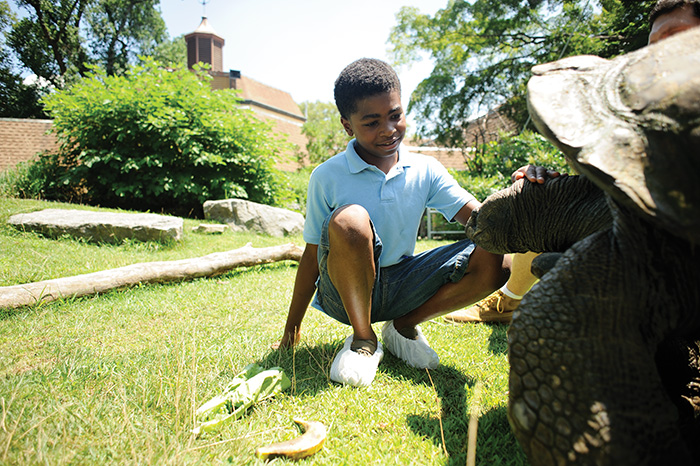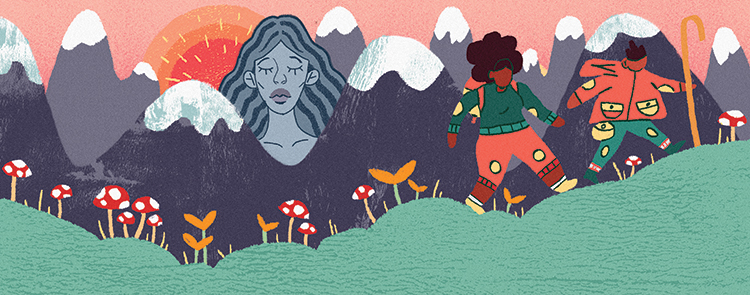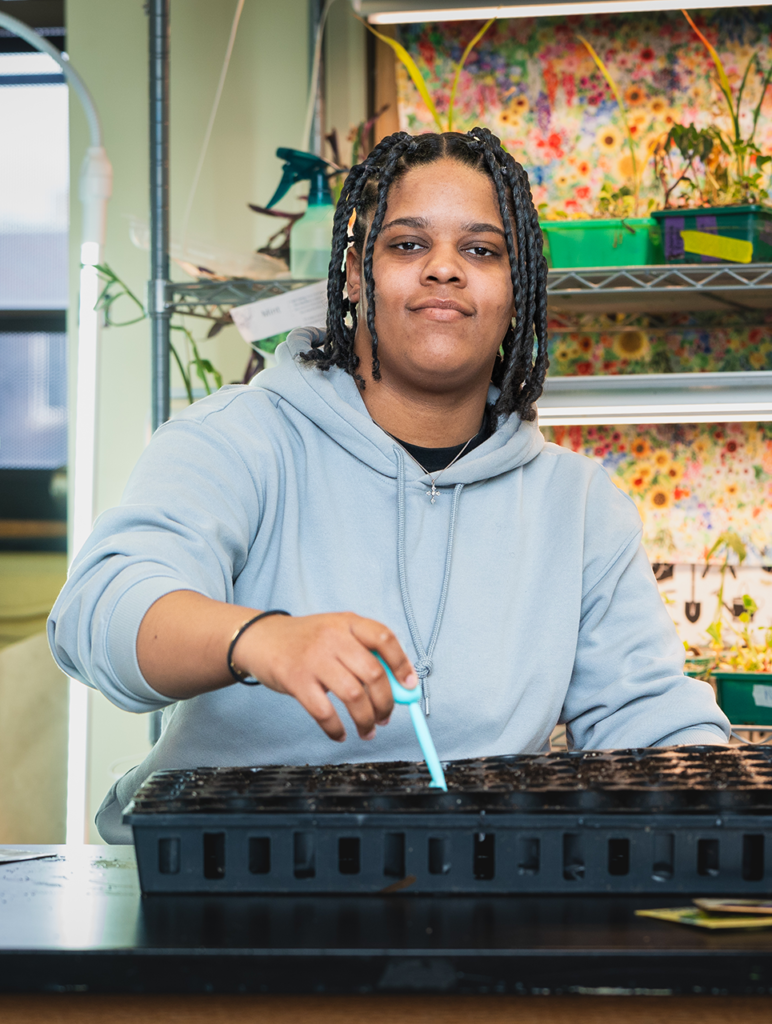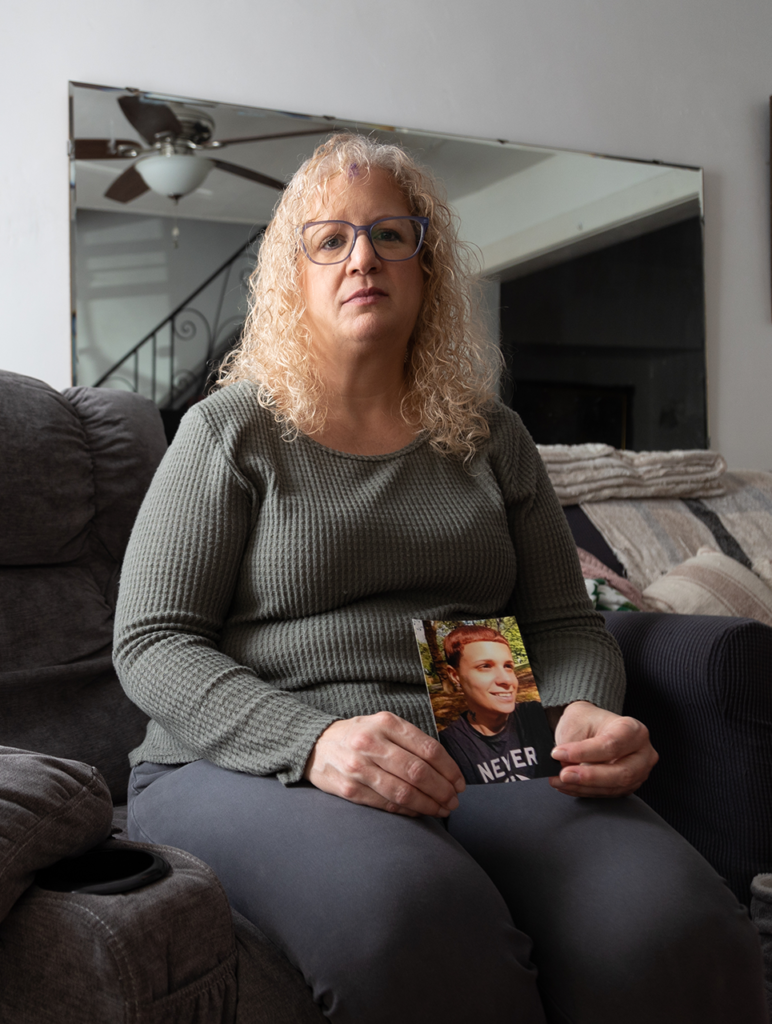Photo by Albert Yee
Endangered tigers and gorillas are now roaming the grounds at the Philadelphia Zoo. Can its consumer education programs make conservation activists of the humans walking among them?
By Alex Mulcahy
Inside the Rare Animal Conservation Center at the Philadelphia Zoo, 21-year-old Aaron Pettyjohn dumps a pile of trash on the floor. He’s trying to attract the attention of Zoo visitors, specifically the youngest among them, but his competition is spectacular. Across the hallway behind plated glass are naked mole rats, blue-eyed black lemurs, golden lion tamarins and a dozen more exotic, unusual and endangered species, the sight of which launch pointed fingers and exclamations of “Look!” Cell phones and cameras emerge hurriedly from pockets.
Pettyjohn somehow finds an audience. Two brothers, maybe five and seven years old, break away from their parents and begin picking up the items strewn about the floor. Soon they are sorting the quesadilla containers, zoo maps and aluminum cans that a Zoo visitor may well encounter during a visit, and tossing them into containers marked “aluminum,” “plastic” and “paper.” The boys do well, misidentifying only the plastic wrapper used for rain ponchos.
You might think otherwise, but Pettyjohn’s passion is not for #2 plastics. The Bucks County resident is a rising senior at the University of Rhode Island who hopes to be a veterinarian at a zoo. Yet he effortlessly rattles off facts that suggest he is a recycling junkie, and offers considered opinions about the limitations of plastic recycling and the serious toll that plastic places on our oceans.
The role of zoos is fast evolving, and the Philadelphia Zoo—the oldest zoo in the country—is among the leaders nationally. While they are, and remain, places to learn about and connect with wildlife—Executive Director Vikram Dewan calls the Zoo “Philadelphia’s largest outdoor classroom”—they are now simultaneously educating visitors about the wonder of our world, and the human behaviors that threaten it.
Valerie Peckham, the Zoo’s Conservation Program Manager, says of the shift, “We are trying to get people to not so much think, ‘We’ve got biodiversity, wildlife and nature over here, and then you [have] people—and the houses we live in, and everything else—over there.’ We are all a part of the same system, and we all rely on the same resources. By protecting wildlife, you are helping people just as much. That’s a connection that a lot of people don’t make, but that is the overarching context.”
Recycling education, and awareness about energy and water usage is part of the Zoo’s commitment to empowering visitors to combat climate change. Now the Zoo is helping to transform some of the 1.3 million people who visit into advocates for “deforestation-free palm oil.” Zoos are becoming agents of change.
It’s a national trend. The Cincinnati Zoo has recycled over 60,000 cell phones in the past four years. The Houston Zoo, not far from the Gulf of Mexico, recently stopped offering plastic bags in their gift shop as a means to raise awareness about plastic pollution in waterways. At the Philadelphia Zoo, the primary educational focus is on climate change and palm oil.
Pete Riger, vice president of conservation at the Houston Zoo, says, “In the last 30 years, zoos have seen that conservation of wildlife and habitats … are so important to their mission and their goals that they really need to… get that focus out and the message out better to the public. Zoos over the last 20 years have been doing a great job of bringing it to the forefront.
data-animation-override>
“The Philadelphia Zoo is really a good example of focusing local to national impact,” he continues. “That’s why you see all the messaging when you go to their zoo. I think a lot of zoos are following suit in trying to get that message across to guests that there are simple actions that you can take from home in order to save wildlife.”
In 1859, the Zoo’s founders could not have imagined a makeshift game of trash basketball inside a Zoo building, but they also would have been hard-pressed to imagine the scale and demands of modern industry, which has dramatically and systematically destroyed wildlife habitats. Conservationists know that the wilderness and animals they cherish can’t be preserved without addressing how humans live.
It’s also clear that cultivating the next generation of environmental leaders is of the utmost importance. “We have this incredible opportunity to reach so many kids on so many issues,” says Dewan.
Indeed, many people who work at zoos were smitten at a young age by a love of wildlife. The Zoo has over 1,300 animals, all potential gateways to a life of treasuring the natural world. The Zoo’s job: Make the connection between humans and animals, and then between humans and habitat.
Falling in love with animals is key
A few hours later, we return to the Rare Animal Conservation Center to photograph Vice President of Conservation and Education Kim Lengel in front of her beloved Rodrigues fruit bats, which hail from a small island off the coast of East Africa. These aren’t technically hers—she hasn’t been a zookeeper in years—but they served as the subject of her graduate degree in biology from Villanova, and she’s devoted much of her adult life to protecting them. The bats are the first animals on display in the building—clearly, it matters who you know—and visitors are immediately greeted with an unmistakably pungent, earthy smell. Lengel likes the aroma.
“Look at that face!” Lengel exclaims. “It’s like a puppy dog with wings.”
Lengel’s fascination with wildlife dates back to early childhood, when her father would read her books about nature, and then take her to nearby creeks and ponds. “We had this one that was my favorite that was called On Small Pond. I would pretend the pond we visited was Small Pond. For me, it was great. I loved being in the muck and handling animals and learning about them.”
In 1988, Lengel started at the Zoo as an intern “on a whim.” Once there, she became enamored with bats. Eventually she took a three-week course with Gerald Durrell, a charismatic and influential zoologist who founded a zoo on the island of Jersey, part of the Channel Islands between France and Great Britain. Durrell, a champion of the Rodrigues bat, helped to reframe the purpose of zoos as places to rescue—and breed—endangered animals, with the hope that one day they could be reintroduced into the wild.
Lengel went on to do graduate work, studying the bats, and then field work in Rodrigues. The bats’ resurgence is a major success story. At one point, there were thought to only be 100 left, and now there are over 20,000. It’s a success story that can partly be credited to the work that Lengel and the Philadelphia Zoo did—and continue to do. The Zoo funds a full-time position for a Rodrigues-based conservation group that protects the bats, among other species.
Standing in front of the bats, Lengel explains her fascination further. They’re the only flying mammals, and with more than 1,000 known types of bats, are an incredibly diverse species. Some bats echolocate, using sound to navigate the world, but some have working eyes. What were the evolutionary pressures, she wonders, that drove them to flight? Did the big bats evolve separately from the small bats? And then how did all of the unique co-evolutionary relationships between bats and the night flowering plants they pollinate—such as guava—come to be?
Then she tells a story about being on Rodrigues at dusk, overlooking a ridge and seeing the fruit bats fly three or four feet above her head, struggling to get out of the valley below. “To see them hanging in the trees, and in the sun… when they are exposed to the direct sun, they gleam.”
Are bats beautiful because they’re fascinating, or are they fascinating because they’re beautiful? Either way, this is the deep connection the Zoo wants their visitors to feel, and then they want that feeling to inspire action.
Changing the experience of visitors and animals
Very few institutions attract such a wide variety of people as zoos, and Philadelphia is no exception. This means attitudes and education around sustainability and conservation will exist on a wide continuum. This puts the Zoo in a unique position.
data-animation-override>
“We are a conservation organization that attracts non-conservationists,” says Andy Baker, chief operating officer of the Zoo. “Ninety percent of our visitors are local constituents, and it is pretty reflective of the diversity—economic, ethnic, education [level] and so on—of our community. So, we do see ourselves as having a broader appeal than something like the Nature Conservancy or the Wildlife Fund. Obviously, they serve extremely valuable roles, but they’ve got the choir. We’ve got the people who aren’t part of the choir yet.”
Like Lengel, Baker has been with the Philadelphia Zoo for over two decades. And, also like Lengel, his interest in the natural world was formed early. Baker devoured books about the fictional Dr. Doolittle, whose central character is able to understand the speech of animals, and he even briefly oversaw a homemade zoo (admission: 25 cents) when he was a child growing up in Arizona. He attended Stanford, and then worked at the Los Angeles Zoo, followed by a stint at the National Zoo in Washington D.C. before joining the Philadelphia Zoo in 1992 as assistant curator of mammals.
By the time he arrived in Philadelphia, he had already done several years of field work in Brazil studying golden lion tamarins. (They are the second animals you encounter when visiting the Rare Animal Conservation Center, living right next door to Lengel’s Rodrigues fruit bats.) He, too, cites his primary inspiration from Gerald Durrell, and his view that zoos should serve as “arks” for endangered animals, and also gives credit to his mentor Devra Kleiman, whom he worked with at the National Zoo. Kleiman, in 1972, was the first female scientist hired in the U.S. by a zoo, and was one of the founders of a Brazilian organization that, through an unprecedented collaboration among zoos, forged an international alliance to save the golden lion tamarins. Baker continues to serve as a special advisor to the board of directors of the nonprofit Save the Golden Lion Tamarin.
These days, Baker is most excited about Zoo 360, the revolutionary overhead trails the Zoo introduced in 2011. Now, both visitors and the animals are having new experiences.
According to Baker, “The Zoo 360 trail concept was really driven from an animal well-being standpoint—that was its inspiration, but we also recognized early on in the development of it, it had a lot of potential to have a positive impact on guest experience, as well. We are definitely seeing that. It creates a more unpredictable experience. I think it repositions the relationship in an interesting way, and that is an area I am interested in digging into. It puts the animals much more in the driver’s seat; if they want to move away from something, they can. In many cases, they are above the visitor. I think it puts people and animals in different relationships rather than a traditional setting. People immediately get it.”
Animals can now engage in high-speed, long-distance running, and, for the Zoo’s mother lion, it has provided a little separation from her cubs. And who would begrudge a mother lion a little alone time?
Again, the hope is that the immediacy of the zoo experience translates into action or behavioral change of the visitors. But for the past few years, the Zoo has been exploring a different approach: encouraging behavior first.
“So, you have these amazing experiences with animals,” Baker says. “We tell you they are in trouble, then we expect behavior change to happen. So, that’s still a critical part. We see the empathy building and experiences being a core part of how we accomplish our mission.
“We have also really pushed ourselves in the last few years to the reverse [of] a kind of ‘caring leads to doing,’” he continues. “A model for that is a Habitat for Humanity … We give them something to work on, and that makes them feel part [of something], reinforces their existing identity of already being green, which encourages further action. That is why we have moved towards—as much as possible—trying to create opportunities for action while people are on site so they have already done something before they leave the Zoo.”
Empowering kids to change behavior
When it comes to climate change, the message of the Zoo is direct, simple and positive: What you do matters. Here’s the simple logic displayed on a sign in KidZooU, their award-winning exhibit designed for kids, to encourage kids to “save” the budgie, a bird native to New Zealand:
data-animation-override>
“Making new cans, bottles and paper requires electricity…“ Much of the energy comes from power plants that burn fuel…
“ Burning fuels makes greenhouse gases…
“ Greenhouse gases trap heat from the sun…
“ The heat causes climate change…
“ Climate change causes droughts where budgies live…
“ Recycle and re-use everything you can to save budgies.”
Suddenly, climate change is less abstract. A loveable, furry face needs some help.
“We know that kids are often the drivers for… behavior in their households, so we are really appealing to the kids as the ‘wildlife heroes,’” says Lengel.
The Zoo primarily addresses climate change by encouraging personal actions, such as recycling, and using less energy and water at home. Since they are aiming at educating children, and because the Zoo is such a mainstream organization, the more radical messages about consumption—the ideas that question what is at the heart of our current economic model—won’t be found at the Zoo. They will tell you to turn off your TV, but not to destroy it.
Regular visitors will notice signs scattered throughout the campus aimed at adults that call attention to technologies and strategies the Zoo has employed to use resources more wisely. Dad can learn about the resource-saving qualities of a waterless urinal, while any passerby might read about the benefits of an energy-efficient geothermal heating and cooling system, like the one the Zoo has.
“Our goal is very much to meet people where they are,” says Dewan. “With someone that is coming in with a double stroller for the day and [has] a lot of things to do, perhaps the best you can hope for is just one or two quick messages.”
Save an orangutan, call a corporation
There is an overwhelming and immediate danger that is alarming to conservationists: palm oil production.
Palm oil is remarkably versatile—it can be found in your chocolate bar, your shampoo and, in some parts of the world, your gas tank. It’s a very lucrative crop that’s in high demand. As recently as 1990, palm oil production accounted for 37 million acres of land; by 2020, projections are that it will reach 185 million acres. This is bad news for some of the stars of our zoos, especially Sumatran tigers and orangutans. If palm oil production goes unchecked, these animals will soon become extinct.
Feeling the urgency to address this issue, the Philadelphia Zoo decided that they would encourage advocacy among their visitors.
Fitting in with their overall approach, the Zoo took a positive tone with the initiative. Their 2011 “Leaves of Gratitude” campaign collected 53,000 handwritten thank-you notes from the community, sent them to corporations that had created any policy attempting to improve their supply chain, and urged them to do more.
Initially, the Zoo supported the Roundtable for Sustainable Palm Oil (RSPO), an NGO established by members of the palm oil industry. While Peckham sees value in the work they’ve done to establish best practices for palm oil producers, there is a very big piece of the puzzle they are not addressing: deforestation.
Despite the outcry of environmentalists everywhere, the RSPO continues to label palm oil “sustainable” that is being grown on newly destroyed tropical forests, the habitat of many endangered species.
“We no longer use the term ‘sustainable palm oil’ because that’s the language used by the RSPO,” Peckham says. “We don’t feel the standards used by the RSPO to certify palm oil as ‘sustainable’ are strong enough, so we advocate for palm oil that goes beyond RSPO and is ‘deforestation-free.’”
Miriam Swaffer, corporate policy advocate at the Union of Concerned Scientists, sees progress, citing the stated support of deforestation-free palm oil by the U.N., the World Bank, governments and the business community. As consumers learn more, she says, business as usual will not be acceptable, and corporations will feel pressure to do the right thing.
Some of that pressure, even if it is applied gently, is coming from the zoo community, and Swaffer sees the Philadelphia Zoo as a national leader in this movement. “This has been a big sea change for the zoo community,” she says, “to get involved in direct advocacy, especially around corporations. I think the Philadelphia Zoo and particularly Valerie Peckham has been so instrumental in normalizing this kind of action… [making zoos] epicenters for taking action in the world.”
The Philadelphia Zoo, and zoos everywhere, can have a profound impact. Dewan points out, “I think it’s not only the depth and diversity of the individuals that we reach, but also the scale.”
The Houston Zoo’s Pete Riger agrees. “Zoos in the U.S. have 180 million people walking into our gates every year, so we have an audience. If we can get that message out to them, we will have a great impact, because you are already engaged. You come to the zoo for a reason, you want to come to the zoo, you want to have fun and you want to see animals, so you already care. So, we already have that piece. Now once you are there, we have to engage and get you to understand how simple it is to help us save animals.”
So, there is reason for hope, but when asked if he retained optimism about the future, Philadelphia Zoo COO Baker paused before answering.
data-animation-override>
“I think what I always go back to is we can make a difference and it may not be… the end result may not be everything that we might want, but we can make the end result better than what it would have been if we hadn’t acted. That’s always the lens I try to put on everything that we do. You lose more battles than you win in conservation biology, but you can change outcomes, and I think that is what we are here to do.”










